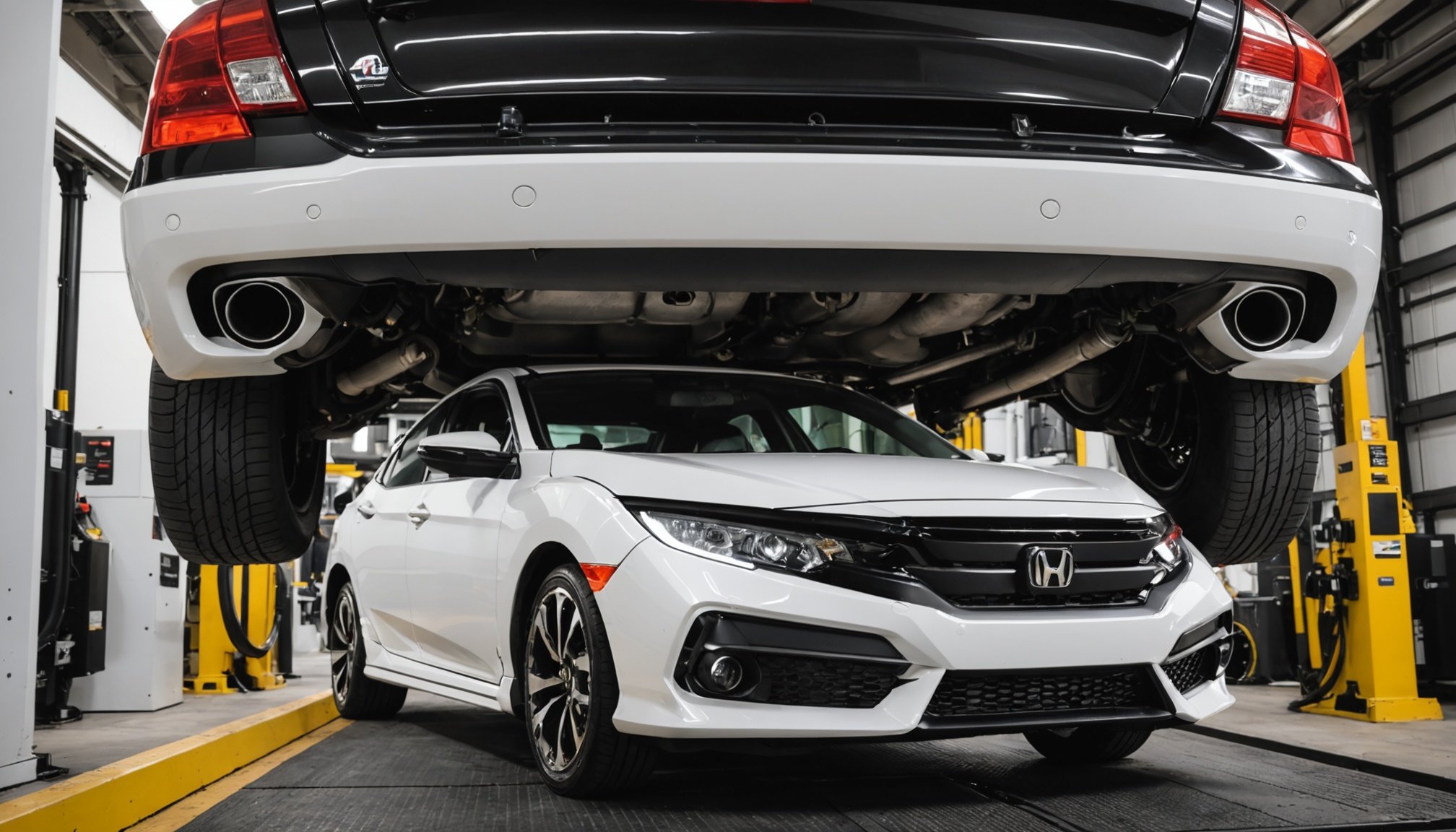Understanding Performance Exhaust Systems
A performance exhaust system plays a crucial role in enhancing a vehicle’s engine performance while often improving fuel efficiency. Unlike stock systems, performance exhaust systems are designed to optimize exhaust flow and reduce backpressure, which can result in better engine combustion and power. These systems typically feature larger diameter pipes and free-flowing mufflers that allow exhaust gases to exit the engine more efficiently.
For Honda Civic owners, upgrading to a performance exhaust system can offer significant benefits. These upgrades can lead to improved engine responsiveness and potential gains in horsepower. One of the primary advantages is the potential for enhanced fuel efficiency, as the optimized exhaust flow allows for more complete fuel combustion.
Also read : Ultimate guide to maintaining your toyota prius hybrid battery for peak performance
Materials used in performance exhaust systems are a key factor in their effectiveness. High-quality stainless steel or titanium is often used for its durability and ability to withstand the high temperatures associated with exhaust gases. Additionally, advanced technologies such as mandrel bending ensure smooth airflow within the exhaust pipes, further contributing to performance gains.
In summary, performance exhaust systems are a valuable upgrade for those looking to improve their vehicle’s performance characteristics, particularly for models like the Honda Civic.
In parallel : Ultimate guide to installing heat-resistant window film in your mercedes-benz gle: tips and techniques for optimal results
Mechanisms of Improved Fuel Efficiency
Installing a performance exhaust system can notably boost your car’s fuel efficiency through enhanced exhaust flow and increased combustion efficiency. These systems are engineered to reduce exhaust backpressure by enlarging pipe diameters and utilizing free-flowing mufflers, allowing exhaust gases to escape more swiftly.
The accelerated exhaust flow lessens the workload on the engine. Consequently, this reduction in workload means the engine doesn’t have to consume as much fuel to sustain power output, effectively improving combustion efficiency.
A pivotal aspect of these systems is their role in optimizing how the engine expels exhaust gases. By minimizing restrictions, a performance exhaust system ensures that the engine breathes better. This efficient breathing nature significantly impacts fuel efficiency, as it makes room for the engine to burn fuel more effectively and completely.
Reduced backpressure further aids in streamlining engine operations, as it optimizes the process of combustion. The benefits aren’t just limited to fuel consumption. The knock-on effect includes engine longevity and consistent power delivery, which culminates in a more efficient vehicle. Overall, this refined workflow empowers your Honda Civic to achieve better mileage, making it an attractive upgrade for those prioritizing both performance and economy.
Comparing Stock vs. Aftermarket Performance Exhaust Systems
Enhancing your Honda Civic’s performance often involves weighing the pros and cons of stock exhaust systems versus aftermarket options. Stock systems are generally designed with cost and mass production in mind, which can limit their capabilities. They may feature smaller pipes and restrictive mufflers, resulting in reduced performance potential.
Features of Stock Exhaust Systems
Stock systems are typically quieter and abide by stringent emission regulations, but this often comes at the expense of performance. Their design prioritizes low noise levels and cost-efficiency, commonly limiting the diameter of exhaust pipes and employing restrictive mufflers. Consequently, they are less effective in optimising exhaust flow and reducing backpressure.
Benefits of Aftermarket Systems
On the other hand, aftermarket systems offer significant advantages. These systems are tailored for performance, featuring larger pipes and free-flowing mufflers that enhance exhaust flow. Materials like stainless steel or titanium not only boost durability but also improve fuel efficiency.
Performance Comparisons and User Experiences
Many users have noted distinct improvements in engine responsiveness and power delivery after switching to aftermarket systems. Testimonials often highlight tangible increases in horsepower and enhanced driving experiences, painting these upgrades as worthwhile investments.
Supporting Data and Research
Performance exhaust systems can significantly impact fuel efficiency, a feature widely acknowledged in scientific studies. Research shows these systems improve exhaust flow, essential for efficient combustion and ultimately better mileage. By allowing exhaust gases to exit quicker, the engines operate at optimal levels with reduced backpressure. This streamlined gas flow results in less fuel being required for maintaining the same power output, offering tangible fuel savings.
Comparative data from Honda Civic enthusiasts often highlights improved fuel consumption post-installation. For instance, drivers report noticeable gains in mileage, linking these to the enhanced capabilities of aftermarket performance exhaust systems. Real-world examples from Civic owners frequently emphasize empowered performance alongside increased fuel economy, forging a harmony between power and efficiency.
Experts advocate for the upgrade, pointing to its positive effects on vehicles’ operational parameters. They underline that while the initial investment might seem substantial, the recurring benefits in terms of fuel savings and boosted engine performance validate this expense over time.
Industry insights further correlate performance exhaust installations with prolonged engine life. Given the natural alignment with improved efficiency, these systems undoubtedly contribute to a rewarding driving experience for Honda Civic owners.
Installation Considerations and Recommendations
Deciding between professional installation and a DIY approach is crucial when considering a performance exhaust system. Professional installation guarantees expertise and precision, often resulting in a secure fitment and compatibility with your Honda Civic. It may also include warranties which provide added peace of mind. However, the cost can be substantial.
Conversely, a DIY installation allows for a more budget-friendly approach. It offers the opportunity to learn and appreciate your vehicle’s mechanics personally. Nevertheless, it’s essential to have adequate tools and a fundamental understanding of the installation process. Mistakes here could jeopardize fuel efficiency and vehicle performance.
Fitment and compatibility are key factors to consider during installation. Ensure the chosen system aligns with your Honda Civic’s specifications to avoid any performance discrepancies. Illustrate alterations clearly if required.
In terms of maintenance, regular checks for leaks, secure fittings, and appropriate alignment will help keep the performance exhaust system efficient and effective. Cleaning components regularly can help prevent build-up that may impact performance.
In conclusion, both paths have merits, but consider your skills, tools, and vehicle requirements before embarking on the performance exhaust system installation journey.
Tips for Maximizing Fuel Mileage
Following the installation of a performance exhaust system, Honda Civic owners can take additional steps to maximize fuel mileage. Firstly, adopting efficient driving habits can make a substantial difference. For instance, maintaining a steady speed and avoiding harsh acceleration or braking can significantly boost fuel efficiency.
It is also beneficial to consider extra modifications that align with your newly installed system. Upgrading to a high-performance air intake system or opting for lightweight wheels can complement the exhaust system enhancements, further improving overall engine performance and fuel efficiency.
In pursuit of better mileage, it’s crucial to adhere to regular maintenance schedules. Ensure that components such as air filters, spark plugs, and tyre pressure are checked frequently to maintain optimal vehicle health and performance.
For long-term strategies, regularly assessing the system for leaks and ensuring that components are well-aligned and secure helps in preserving efficiency. This maintenance can include periodically cleaning the exhaust to prevent carbon build-up.
Overall, by integrating mindful driving practices with strategic mods and consistent maintenance, Civic owners can significantly improve their vehicle’s fuel efficiency and performance longevity.




